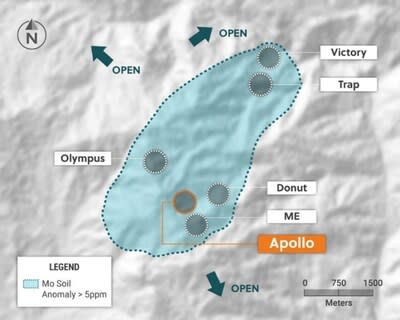- Assay results for drill hole APC-31, which is the first hole to test the mineralized outcrop of the Apollo porphyry system (*formerly known as the Main Breccia discovery), has intersected significant continuous high-grade copper-silver-gold mineralization from surface as follows:
- High-grade oxide mineralization was encountered over the initial 42.35 metres of the drill hole averaging 5.08 g/t gold equivalent.
- Five additional drill holes have been completed in 2023 to date from drill Pads 6 and 7. All five holes appear to have cut significant mineralization beginning at bedrock with the three completed holes from Pad 6 intersecting more than 350 metres of continuous mineralization and the two outstanding holes from Pad 7 intersecting more than 100 metres and 170 metres of continuous mineralization, respectively. Assay results for these holes are expected in the near term.
- Outcrop mapping and sampling in the south and central portions of the Apollo porphyry system has outlined a 130 metres X 130 metres area of known surface mineralization which is open in all directions. Two new pads (9 and 10) are under construction and once operational will provide more drilling options to test this expanding area of surface and shallow mineralization.
Ari Sussman, Executive Chairman commented: “2023 is off to an excellent start to say the least. Not only did drill hole APC-31 confirm for the first time that the high-grade copper-silver-gold mineralization in the Apollo porphyry system comes right to surface, but also that there is a significant zone of high-grade oxide mineralization. We have truly discovered a remarkable porphyry system at Apollo characterized by unusually high-grades of combined gold, silver and copper. We are equally fortunate that our Guayabales project is located in a mining camp contiguous to the multi-million-ounce Marmato mine and are confident that our Apollo porphyry system will play a key role in Colombia’s decarbonization strategy. Our plan in 2023 is to remain aggressive with both drilling and ESG so that our “Collective” model for mining yields dividends for stakeholders and shareholders alike.”
TORONTO, Feb. 23, 2023 /CNW/ – Collective Mining Ltd. (TSXV: CNL) (OTCQX: CNLMF) (“Collective” or the “Company”) is pleased to announce assay results from the first drill hole of 2023 as part of the Company’s phase II drill program at the Guayabales project located in Caldas, Colombia. The aim of the phase II program is to test and define through drilling the shallow portion of the Apollo porphyry system (*formerly known as the Main Breccia discovery) as well as continue expanding the system through step-out drilling. The Apollo porphyry deposit is a high-grade, bulk tonnage copper-silver-gold system, which owes its excellent metal endowment to an older porphyry copper-silver and gold mineralization being overprinted by younger precious metal rich, carbonate base metal vein systems (low and intermediate sulphidation) within a magmatic, hydrothermal intermineral breccia body currently measuring 395 metres x 385 metres x 915 metres and open for expansion.
Details (See Table 1 and Figures 1-3)
Assay results for the first drill hole (APC-31) from the 2023 phase II program is announced in this press release. The Phase II drilling program of 2023 is advancing on schedule with six holes completed and a further three in progress. The aim of this program is to define the high-grade mineralization and dimensions of the Apollo porphyry near surface while continuing to expand the size of the system through step-out drilling.
To date, a total of 32 drill holes (approximately 15,400 metres) have been completed and assayed at the Apollo target with the majority of the holes testing the Apollo porphyry system.
Assay results and geological observations of APC-31 are summarized below.
APC-31 was a shallow hole, drilled steeply to the northwest from Pad 6 to a maximum depth of 389.6 metres (370 metres vertical). The hole was designed to exclusively test the upper portion of the porphyry system from a location where the system outcrops at surface. The hole intersected continuous mineralization from surface down to its final depth where it was terminated while still in strong mineralization. APC-31 is the highest-grade accumulation of mineralization reported from drilling to date and averaged:
- 384.7 metres @ 2.46 g/t gold equivalent (consisting of 1.17 g/t gold, 43 g/t silver and 0.37% copper) and including;
The mineralized interval starts from surface to 30 metres depth within saprolite material followed by an additional 17.5 metres of saprock with iron oxides and sulphides to 47.25 metres before transitioning into fresh rock consisting of chalcopyrite (0.5% to 1.5%), pyrite (1% to 2.5%) and some pyrrhotite (~1%). The mineralization is overprinted by carbonate-base metal veins containing sphalerite and galena and high grades of gold. Gold grades are significantly higher in the oxidized portion of the intercept down to 47.25 metres, while copper and silver grades are reduced within the same interval presumably due to weathering.
Outcrop mapping and sampling in the south and central portions of the system has outlined a 130 metre-by-130 metre area of known surface mineralization, which is open in all directions. 2023 drill Pads 6 and 7 have been designed to achieve the objective of understanding the styles and tenor of the shallow, high-grade mineralization from surface down to depths of up to 400 metres. Visual observations from five completed holes that are awaiting assay results in the near term indicate continuous intercepts from surface over core lengths ranging from more than 100 metres to more than 350 metres. The Company presently has three diamond drill rigs operating at the project.
Two new drill pads, numbered 9 and 10, are under construction to provide further drilling options to test and expand upon the area which the Apollo porphyry system outcrops at surface.
The Apollo target area, as defined to date by surface mapping, rock sampling and copper and molybdenum soil geochemistry, covers a 1,000 metres X 1,200 metres area, and represents a large and unusually high-grade Au-Cu-Ag porphyry system. Mineralization styles include early-stage porphyry veining, inter-mineral breccia mineralization and multiple zones of late stage, sheeted, carbonate-base metal veins with high gold and silver grades. The Apollo target area is still expanding as the Company’s geologists find more outcrop areas with porphyry veining, breccia, and late stage, sheeted, carbonate base metal veins.
Table 1: Assays Results for APC-31
| Hole ID | From (m) | To (m) | Intercept (m) | Au (g/t) | Ag (g/t) | Cu % | Mo % | AuEq (g/t)* |
| APC-31 | 4.90 | 389.60 | 384.70 | 1.17 | 43 | 0.37 | 0.02 | 2.46 |
| Including | 4.90 | 325.70 | 320.80 | 1.34 | 49 | 0.44 | 0.02 | 2.84 |
| 4.90 | 114.70 | 109.80 | 3.15 | 45 | 0.25 | 0.01 | 4.14 | |
| ** | 4.90 | 47.25 | 42.35 | 4.81 | 23 | 0.09 | 0.001 | 5.08 |
*AuEq (g/t) is calculated as follows: (Au (g/t) x 0.95) + (Ag g/t x 0.016 x 0.95) + (Cu (%) x 1.83 x 0.95)+ (Mo (%)*9.14 x 0.95) and CuEq (%) is calculated as follows: (Cu (%) x 0.95) + (Au (g/t) x 0.51 x 0.95) + (Ag (g/t) x 0.01 x 0.95)+ (Mo(%)x 3.75 x 0.95) utilizing metal prices of Cu – US$4.00/lb, Ag – $24/oz Mo US$20.00/lb and Au – US$1,500/oz and recovery rates of 95% for Au, Ag, Mo and Cu. Recovery rate assumptions are speculative as no metallurgical work has been completed to date. A 0.2 g/t AuEq cut-off grade was employed with no more than 15% internal dilution. True widths are unknown, and grades are uncut
**Zone of Oxidation


About Collective Mining Ltd.
To see our latest corporate presentation and related information, please visit www.collectivemining.com
Founded by the team that developed and sold Continental Gold Inc. to Zijin Mining for approximately $2 billion in enterprise value, Collective Mining is a copper, silver and gold exploration company with projects in Caldas, Colombia. The Company has options to acquire 100% interests in two projects located directly within an established mining camp with ten fully permitted and operating mines.
The Company’s flagship project, Guayabales, is anchored by the Apollo target, which hosts the large-scale, bulk-tonnage and high-grade copper-silver-gold Apollo porphyry system. The Company’s near-term objective is to drill the shallow portion of the porphyry system while continuing to expansion the overall dimensions of the system, which remains open in all directions.
Management, insiders and close family and friends own nearly 52% of the outstanding shares of the Company and as a result, are fully aligned with shareholders. The Company is listed on the TSXV under the trading symbol “CNL” and on the OTCQX under the trading symbol “CNLMF”.
Qualified Person (QP) and NI43-101 Disclosure
David J Reading is the designated Qualified Person for this news release within the meaning of National Instrument 43-101 (“NI 43-101”) and has reviewed and verified that the technical information contained herein is accurate and approves of the written disclosure of same. Mr. Reading has an MSc in Economic Geology and is a Fellow of the Institute of Materials, Minerals and Mining and of the Society of Economic Geology (SEG).
Technical Information
Rock and core samples have been prepared and analyzed at SGS laboratory facilities in Medellin, Colombia and Lima, Peru. Blanks, duplicates, and certified reference standards are inserted into the sample stream to monitor laboratory performance. Crush rejects and pulps are kept and stored in a secured storage facility for future assay verification. No capping has been applied to sample composites. The Company utilizes a rigorous, industry-standard QA/QC program.
Information Contact:
Follow Executive Chairman Ari Sussman (@Ariski) and Collective Mining (@CollectiveMini1) on Twitter
FORWARD-LOOKING STATEMENTS
This news release contains certain forward-looking statements, including, but not limited to, statements about the drill programs, including timing of results, and Collective’s future and intentions. Wherever possible, words such as “may”, “will”, “should”, “could”, “expect”, “plan”, “intend”, “anticipate”, “believe”, “estimate”, “predict” or “potential” or the negative or other variations of these words, or similar words or phrases, have been used to identify these forward-looking statements. These statements reflect management’s current beliefs and are based on information currently available to management as at the date hereof.
Forward-looking statements involve significant risk, uncertainties, and assumptions. Many factors could cause actual results, performance, or achievements to differ materially from the results discussed or implied in the forward-looking statements. These factors should be considered carefully, and readers should not place undue reliance on the forward-looking statements. Although the forward-looking statements contained in this news release are based upon what management believes to be reasonable assumptions, Collective cannot assure readers that actual results will be consistent with these forward-looking statements. These forward-looking statements are made as of the date of this news release, and Collective assumes no obligation to update or revise them to reflect new events or circumstances, except as required by law.
Neither the TSXV nor its Regulation Services Provider (as that term is defined in the policies of the TSXV) accepts responsibility for the adequacy or accuracy of this news release.
SOURCE Collective Mining Ltd.







